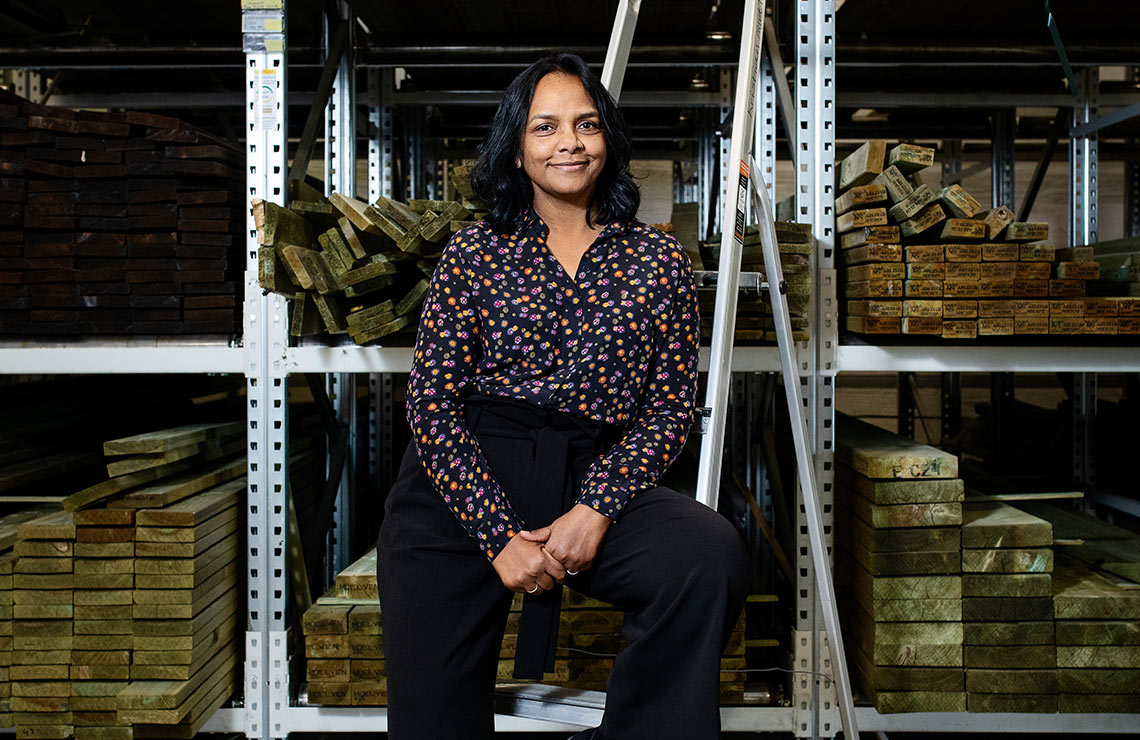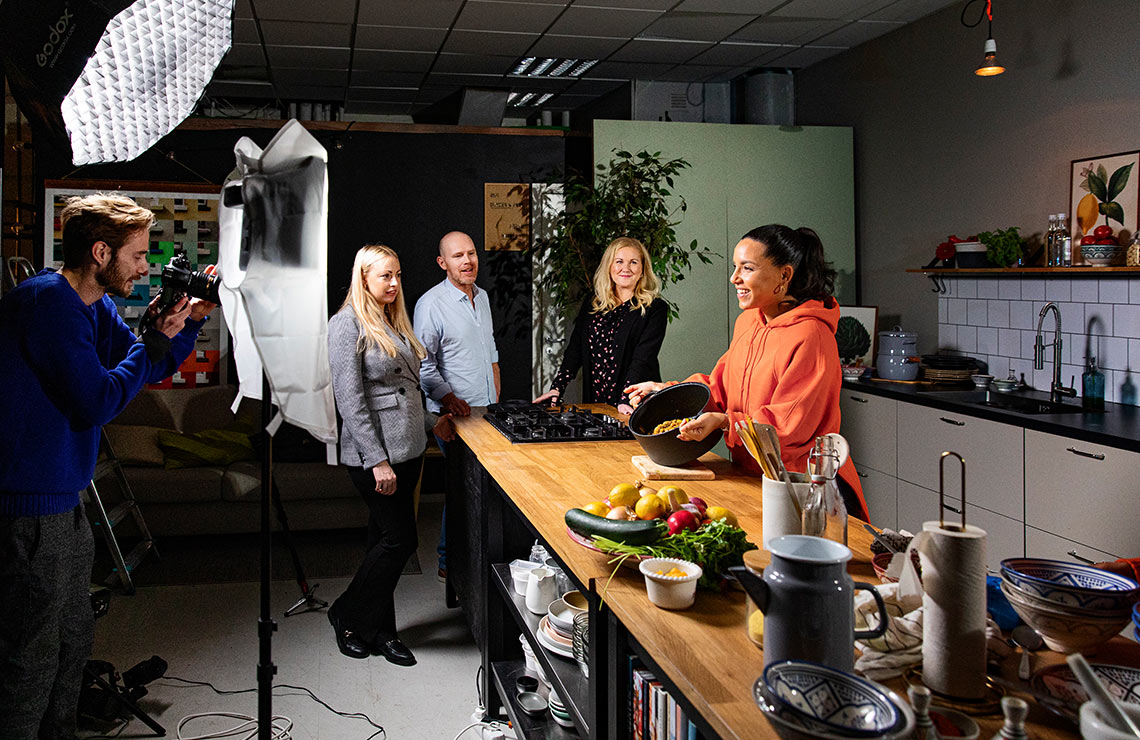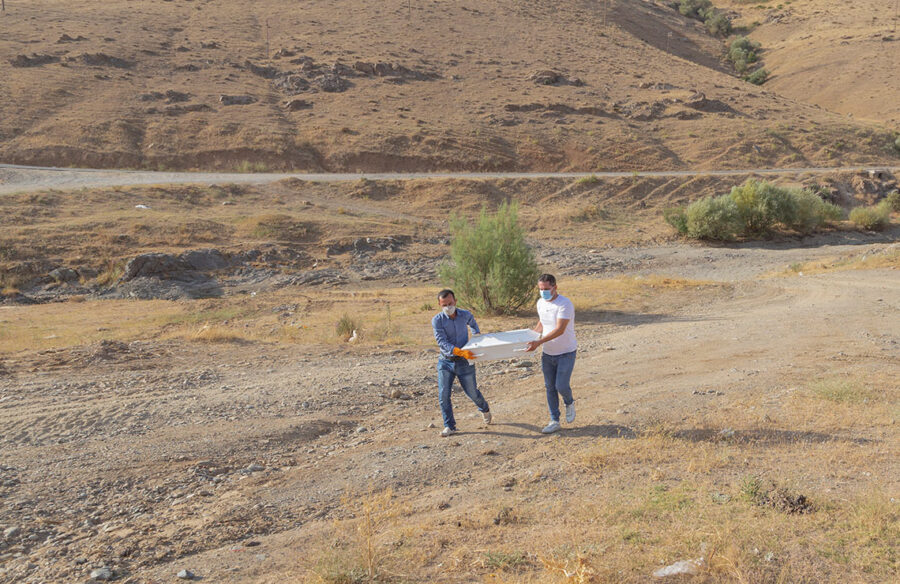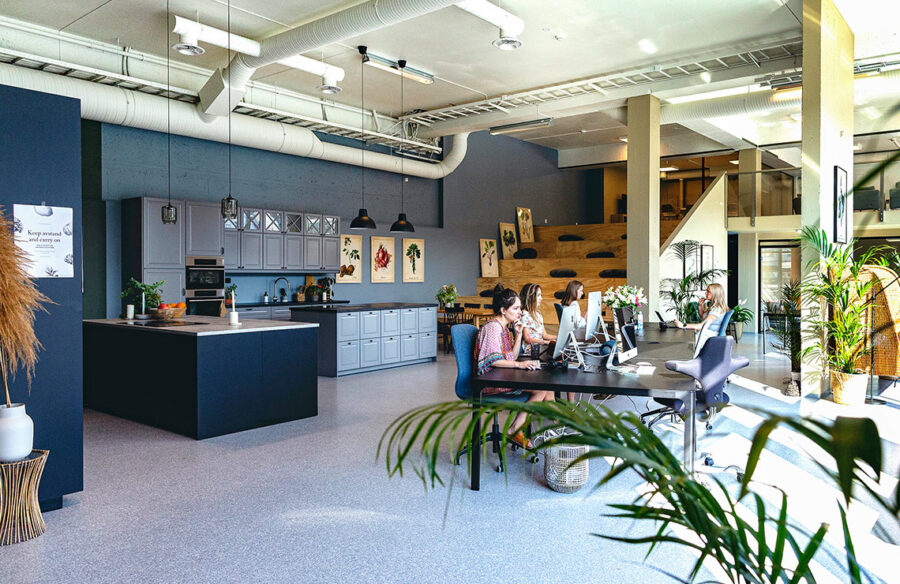Meet our People: Unlocking the Schibsted universe

Meet our People
With Schibsted Account, Ida Kristine Norddal and her team has a powerful tool to explain Schibsted offers, Armin Catovic is developing contextual advertising and Ralph Benton is making sure Schibsted is safe. Get to know some of our people.
Unlocking the Schibsted universe
With more than three million users logged in every day, Schibsted Account is a player you can count on. The service is used to log in to Schibsted’s newspapers, marketplaces and other digital services, and it has become the way that most end users engage with the Schibsted brand.
Ida Kristine Norddal’s product team and related engineering and UX teams, all within the User Foundation unit, are growing rapidly to keep up with user needs and to further develop the service and experience.
“We want to step up our game, to make sure the users understand who Schibsted is and that they can trust us with their information,” she explains.
Schibsted Account’s most obvious task is to enable Schibsted users to prove who they are, and by doing so, they get access to our products and services, it also enables subscription offers. But the potential and future ambitions point towards so much more – Schibsted Account is on its way to becoming an important key to the Schibsted universe.
“We also want users to be able to discover and explore all the different things that we offer”, adds Ida Kristine.
She describes this as Schibsted’s hidden treasure – news, buying and selling, ordering breakfast, finding a handyman and a lot more – services that the users can access with their Schibsted account.
“Our ambition is to simplify the whole user experience, making it easy to go between our different services, using the same log-in and, when needed, the same account information”, says Ida Kristine.
No doubt, her team has a lot to do – and many treasures yet to reveal. In between, they also communicate with all these users. Every month they send out more than three million emails, another reason why Schibsted Account is the Schibsted brand’s most important ambassador.
Ida Kristine Norddal
Product Lead, Schibsted account
Years in Schibsted: Almost 4

Serving ads without using tracking
Data is what makes Armin Catovic tick. It’s also one of the reasons why he joined Schibsted – in addition to the fact that he now can use it to do good.
His team has developed a contextual advertising product, which uses data models to identify specific content in articles on Schibsted’s news sites.
“This makes it possible to offer ad segments to our customers, based on news content alone. We don’t need to use cookies or tracking”, Armin explains.
More specifically, it means that advertisers can pinpoint certain keywords to which they want to be connected. The data models find those words in articles on Schibsted’s news sites, and an ad can be placed there.
Recently, Armin and the team developed a more advanced model that can identify broader contexts.
“For instance, bicycle retailers would typically want to be connected to cycling or Tour de France. Now they can have a wider perspective and choose to be seen in stories about climate change, since bikers often cycle to reduce their environmental impact.”
And the advertisers are happy about it.
“Feedback from both our own product specialists and the advertisers has been very positive, and we’ve now reached a monthly revenue target of
1 million SEK/NOK.”
Armin Catovic
Senior Data Scientist & Tech Lead
Years in Schibsted: Almost 1

“It’s about protecting society”
The number of cyber-attacks has increased dramatically in the last ten to five years. Today everyone is a target.
“Like many others, we really need to improve in this area”, says Ralph Benton.
As CISO he has initiated a cyber security program to improve information and IT security, how Schibsted detect and respond to cyber attacks and to educate all employees on security risks.
“It’s about protecting yourself, your colleagues, Schibsted – and in the end the whole society.”
That last thing is particularly valid for a company with media outlets. Except attacks where someone’s trying to steal customer information, or ransomware attacks where someone brings a site or service down – in the fake news era, news sites are facing risks that their content might be manipulated.
As an individual, you should protect your digital identity.
“When possible, use multifactor authentication – like Bankid or OKTA – when not possible, use strong and unique passwords, and do not use the same password everywhere”, urges Ralph.
The good news is that in Schibsted we have already learned a lot.
“When we sent out the last fake phishing attack, a lot of employees reported it to the IT Service Desk and that is really good”.
Ralph Benton
Chief Information Security Officer
Years in Schibsted: 2.5
Meet our people: From trash to bargain

Meet our people
Anjali Bhatnagar started Tørn to make use of hardware overstock, Anton Assarsson creates real value for advertisers and Therese Cappelen is rethinking periods. Get to know some of our people.
From trash to bargain
Did you know that in Norway alone, building materials with a market value of four billion NOK end up in long term storage and ultimately get thrown away? The situation is similar across Scandinavia.
We’re talking about fully functional goods and tools that have been replaced by newer models or were in stock only for a season. When Anjali Bhatnagar heard about this, she knew that it would be her next project. After shutting down a previous project – a marketplace for second-hand fashion, which didn’t fly, she already had a platform and contact with investors, Schibsted being one.
“I realized there are buyers who would be very interested in these supplies, but the stores do not have access to them.”
That’s how Tørn was born, a marketplace for hardware overstock, where you can buy everything from nails to floors and bathroom equipment for a really nice price, and at the same time save the planet from some unnecessary waste. But the key to success is convenience.
“Tørn makes it easier for the stores to sell rather than throw away the goods”, explains Anjali.
“It’s very simple for the sellers to automatically get their goods up on our platform. In return, they get ready orders and even a shipping label from Tørn. We deal with the payment and everything else.”
So far, Tørn has been off to a good start. In only a year, 120 stores have come onboard and another 250 are on their way in Norway – and next year a pilot will be launched in Sweden.
“I have worked with both technology and user centred design in the past, and I strongly believe that both disciplines are relevant tools to create commercially successful and sustainable solutions for real problems.”
Anjali Bhatnagar
CEO and Founder Tørn
Schibsted invested: May 2021

“I really enjoy the creative process”
In 2021, more than 400 million Swedish krona was spent on native advertising in Sweden. There’s no question that a good story is valuable. Anton Assarsson is Head of Editorial for Tailor Made Solutions in Schibsted’s Brand Studio in Stockholm, and he knows that the market has even greater potential to grow.
“Advertisers from all around the world see the potential in getting their message across in a storytelling-fashion on Schibsted’s platforms. And they understand that the readers and viewers appreciate it.”
The key to a successful campaign for him and his team is to take an editorial approach when creating content, and Anton, a former journalist, knows how to do just that.
“I really enjoy the creative process and that I get to use my experience as a journalist to create value for our customers.”
He emphasises that the distinction between commercial and editorial content is critical – and that it should always be obvious to the users that what they are reading is advertising.
“But what is great is that if the storytelling and content are good enough – the readers will choose it, and appreciate it, regardless.”
Anton Assarsson
Head of Editorial, Schibsted Tailor Made Solutions
Years in Schibsted: 8

Syd is rethinking periods
It all started with an interest in how companies can make a difference. Now Syd offers subscriptions for organic tampons and pads – and support to girls on the Ivory Cost.
“I was tired of menstrual products brands being stuck in the past. No one seemed to care about the whole experience,” says Therese Cappelen, one of three founders behind Syd.
A starting point was when she met her co-founders, Adriano Sannelli and Christian Nordenborg. They shared the belief that businesses should also do good.
So, when you subscribe to Syd’s products, you are supporting girls on the Ivory Cost. For every product sold, a percentage of the profit is donated to make sure that they have access to safe toilets with running water and period care. Syd is cooperating with Save the Children to build toilet facilities at six schools in the country.
As a designer, Therese reacted to the excessively pink packaging and branding of menstrual products, which are often decorated with flowers and animal prints. Syd’s blood red and the letters in its name are placed to symbolize a vagina.
“Periods are still associated with a sense of shame and hush-hush. We want to change that,” says Therese.
Therese Cappelen
Co-founder Syd
Schibsted invested: September 2021
Telling the Schibsted story

Telling the Schibsted story
For years Schibsted has been the hidden parent company behind a portfolio of some of the most appreciated companies in the Nordics. Today, Schibsted, a brand that has existed for over 180 years, is also growing into an identity of its own.
Schibsted’s history goes back all the way to 1839 and Christian Schibsted’s printing business. Ever since it’s been a story of transformation, entrepreneurship and carrying the torch for independent media and freedom of speech.
But although it’s a strong and compelling story, it’s not very well-known – for a long time Schibsted has been an unknown owner behind a portfolio of some of the strongest brands in the Nordics. It has always been, and still is, our brands that should shine the brightest. However, the need for a stronger parent brand has gradually risen.
We are becoming consumer-facing
There are many reasons for this. Employer branding and the war for talent requires a clear identity. How do we attract the best people if they don’t know who we are and what we aspire to be?
Promising startups and companies that Schibsted would like to invest in, will want a partner they understand, respect and believe they can build a long-term relationship with.
And, Schibsted is also becoming a consumer-facing brand of its own, with our login and identity service Schibsted account. Owning the data of customers interacting with our companies, also means the need to build trust in Schibsted. And trust demands a certain level of knowledge and understanding of who we are.
That said, in order to build a strong brand, you need to have the right tools in place, and understand that strategy and branding are two sides of the same coin. That’s why, in the spring of 2021, we launched our overarching strategy and identity, Schibsted Future State. This defines what Schibsted is and should aim to be, what sets us apart as a company and why we exist. It’s what we want Schibsted to be, in the hearts and minds of people connecting with us.
Our three main pillars
These are the three main pillars explaining who we are – our mission, our vision and our character:
What do we do? Empower people in their daily lives.
Why do we do it? To uphold a society built on trust and transparency.
How do we do it? As a fearless force for change.
To express what is true and important all across Schibsted we have also created a set of uniting principles. They say something about how we approach business across our family of brands and how we work together. Not every principle will seem relevant all the time, but they set the standard Schibsted brands should aspire to, and codes of conduct that no brand strategy or value should violate.
- We take leading positions
- We create exceptional user value by sharing data and capabilities
- We champion a responsible internet
- We are more than the sum of our parts
- We think big and long term
- We know the power of local.
- We are accountable
- We are entrepreneurial
A family story
Schibsted Future State does not replace our brands’ individual mission, strategy or value. Rather, it serves to complement them. However, it says something about our family, the history and legacy that connect us, and the future we want to create together. What we do want, is for people to understand Schibsted as the parent that orchestrates our family of brands.
It is our ambition, though it may take some time, that most people working in Schibsted will easily be able to sum up what our strategy is. When all our business decisions are aligned with our strategy, when there’s a clear coherency and consistency in how we tell our story to everyone out there; from potential employees, to customers travelling through our digital services and channels that’s when people can start to really evaluate how loveable Schibsted as a brand really is.

Nathalie Kåvin
Head of External Communications & Brand Management
Years in Schibsted: 3.5
Build a brand that gets into people’s heads

Build a brand that gets into people’s heads
The marketing discipline has, of late, been obsessed with short-term performance marketing. It seems that many of us have forgotten the true value of being a brand that people really love. Hanne Hollstedt, Head of Marketing in Schibsted Ventures Norway, is seeing signs of change.
Today, many companies are almost blinded by the urge to gather enough data. It’s all about hitting that exact moment when your customers make a purchase decision – all to reach a certain sales target. Yes, of course tracking, gathering and analysis of data is important. But what happened to building a brand that customers want to buy in the first place?
A common definition of a brand is “a name with the power to influence”, according to reputed brand expert Jean-Noël Kapferer. But creating a brand that evokes love and trust, as well as the power to influence, is rarely at the centre of strategic discussions.
A gut feeling
All too often, brand strategy is left to the marketing team, and the marketing team is measured on short-term conversions. The strategic discussion centres around product, people, technology and KPIs related to revenue growth and costs. It’s tangible and easy to measure.
Honestly, if you ask yourself whether a financially strong competitor would be able to copy your product, technology, people or customer journey, the answer will in most cases be “yes”. But if you ask the same question about your company’s name or brand, and you can answer “no”, then you know you’ve got a winner.
One of a company’s most important assets is the space they occupy in people’s minds; the gut feeling and willingness to pay that they immediately stimulate –and the possibilities their name gives for future growth and opportunities. The sum of all choices that tip things in your favour – now that’s your brand making a difference.
Finn.no is by far the most popular marketplace in Norway, behind which is a large pool of talented developers, sales personnel and product owners. Finn has developed a strong company culture and substantial financial resources. However, all these assets could be copied, in one way or another.
Essentially, there is not a single unique element that you can’t copy or recreate.
However, try to occupy the same space in the heads of the Norwegians that the Finn brand does. That’s hard …really hard. That’s what’s called the performance of the brand.
The short-termism is to blame
So why isn’t the brand a central part of the strategy in all companies?
I think today’s short-termism is partly to blame, but also that the idea of brand is so complicated. To quote Jeremy Bullmore: “Brands are fiendishly complicated, elusive, slippery, half-real, half-virtual things. When CEOs try to think about brands, their brains hurt.”
From an investor perspective, the value of a company is not just the tech stack, production sites or current customer base.It’s whether they have a name with the power to influence future growth. This value lies in the brand. A well-used example, but nevertheless one of the world’s best, is “The Company that shall not be mentioned” who sells 15 percent of all devices in the smartphone category but keeps 66 percent of the global profit pool. No competitor has yet been able to take more than a tiny bite of that apple.
As for marketing, if you need to be right in front of people’s faces to be remembered and chosen, that represents a consistent and high cost. It’s like being trapped in a hamster wheel. Building a brand, on the other hand, is a sustainable, long-term investment.
Recent research shows a not surprising correlation between share of brand searches in a category and the brand’s market share (Les Binet 2020). This means that you also must focus on what triggers customers to search for your specific brand in the first place, rather than put all your focus on the generic searches in your category.
The future winners will be the ones who are able to create a name that increases the chances of customers choosing you over the competition, attracting more customers, at a lower cost, who are happy to pay a little extra for you. They will deliver more revenue, profit, and growth, more efficiently, and ultimately, generate more shareholder value.
The value proposition is crucial
The start-ups that we in Schibsted Ventures meet obviously don’t represent strong brands…yet. They are simply too immature. However, it is possible to identify companies that might have the potential to become powerful brands.
I would argue that start-ups that have a clear value proposition and are able to articulate that through both internal actions and external communication have a head start on their journey to becoming a strong brand. If you know why the users and customers should choose, trust and maybe even love you, you have come a very long way.
This might seem simple and intuitive, but it’s not. Very often a company starts out with some kind of solution that they more or less accidentally developed, without a clear vision of the actual value proposition. That might turn out well, but it also might result in blinding frustration no matter how advanced or clever your performance marketing strategies.
If you take a step back and try to figure out the essence of the market that your start-up is targeting, and what the actual drivers and barriers are, then you have taken the first step to creating a brand that makes a difference – a brand that is your performance.

Hanne Hollstedt
Head of Marketing, Schibsted Ventures Norway
Years in Schibsted: 2.5
For your ears only – the rise of social audio

For your ears only – the rise of social audio
With more than two million shows and in excess of 48 million episodes online (as of April 2021), podcasts are still growing in popularity. The global pandemic also gave rise to a new trend in the audio space: social audio.
Everyone from major publishers to smaller creators are creating podcasts, and the topics are as varied as their hosts. While it’s difficult to find statistics for podcast listening globally, more than 60 percent of American adults from age 18 to 34 listen to podcasts monthly. It’s projected to be a 1 billion USD industry by the end of this year.
Social audio
Still, there’s an even newer phenomenon that has emerged on the audio scene in the last year or so. It’s called social audio. It started when Clubhouse hit the scene in 2020, and it gained a lot of traction as the Covid-19 pandemic had people all over the world sitting at home, starved for human connection. The Clubhouse app was, at the time, invitation-only, growing slowly but steadily over time. But in the wake of its rising popularity, other platforms saw an opportunity.
Platforms that already had significant audiences, such as Twitter, Facebook and Spotify, threw their hats into the ring and created their own versions of places for people to connect via audio. Even Amazon is reportedly creating a live audio business. In gaming, voice chat has been huge for decades, allowing players to talk in-game, and that phenomenon has been extended to external platforms like Discord, which has become more of an all-around voice chat and streaming platform.
As to why audio has become so popular across channels, tech analyst and investor Jeremiah Owyang describes it as a Goldilocks medium. “It’s not as impersonal as text but also not as invasive as video — something particularly important for the Zoom-fatigued user”, he says. There’s also a case to be made for audio as a more human and authentic medium.
Important source of income
For publishers and advertisers, the growing audio space has a lot to offer. Subscription-based products have become some of the most important sources of revenue for publishers, whether paid for by users or advertisers. Audio can also be a way to create stronger connections with your audience and to humanise your brand.
As social audio and, perhaps most notably, podcasts grow, advertisers will follow suit. Global podcast ad spend is predicted to double, reaching 1.6 billion USD in 2022, according to a study by the World Advertising Research Centre (WARC). Another study, the Super Listeners 2021 report by Edison Research, shows that podcast advertisements are the most recalled type of ad, with 86 percent of respondents saying they remember seeing or hearing an ad.
For Schibsted, podcasts are an important part of its core business, as shown by the company’s increased stake in the podcast company Podme. The audio space is especially important in the Nordics, with Sweden being one of the world leaders in podcast listening, according to the German market and consumer data firm Statista. The Nordics have a long history of qualitative audio media, with global tech giants, including Spotify and Acast, originating in Sweden.
Although the audio climate was disrupted at the start of the pandemic, especially with podcasting being a favoured commuting pastime, it didn’t take the expected downturn, but instead came out of the crisis on top. And for everyone from listeners to publishers and marketers, it looks like it’ll keep on climbing.

Camilla Buch
Advisor Editorial Content
Years in Schibsted: 1.5
There’s no going back to brick and mortar

There’s no going back to brick and mortar
The pandemic has permanently changed how we shop, bringing e-commerce firmly into the mainstream. Retail behaviours that started as a Covid-19 necessity will continue even after the long-awaited return to “normalcy”.
The simple explanation for this shift is that convenience always wins, and the pandemic awakened shoppers to a world of seamless deliveries and curb side pick-ups from their favourite big-box retailers. Beyond that, the evolution of shopping has also opened the door for consumers to trade traditional brand loyalties in exchange for the best price, the most eco-friendly or the most socially conscious.
“You’re not going to see a full rollback when it comes to e-commerce penetration”, says Hana Abaza, Shopify Plus’ Global Director of Marketing.
“Some people will actually shift into buying certain things online, and they’ll keep doing it.”
A fierce fight
Given that there’s no going back, let’s look ahead and focus on how e-commerce will continue evolving into a more interactive, virtual and data-driven experience for shoppers, with an emphasis on mobile and social. Driving that innovation in e-commerce is a playing field more competitive than ever. Online customers have quickly flocked to the retailers who could offer a best-in-class user experiences, fluid logistics or frictionless payments. While market leaders such as Amazon continue to shift billions in gross merchandise value (GMV), the fight for a share of the customer wallet remains fierce among the long tail of both old and new players in the online shopping space.
In September 2021, the mobile analytics firm App Annie concluded that the pandemic accelerated e-commerce growth by ten years. Mobile shopping activity spiked worldwide in 2020, and the amount of time spent in shopping apps grew by almost 50 percent. Better mobile experiences have also led to bigger shopping carts, with the average mobile shopping spend rising by 22 percent to 78 USD. Mobile-first retailers are continually rolling out tactics to keep consumers in the app longer, such as games and other interactive elements like chatbots, wish lists and stories.
So, why do we see this defining the next generation of online commerce? Mobile penetration rates are continuing to grow, particularly in previously underdeveloped regions including South America and Southeast Asia. To note: Indonesia experienced an 87 percent rise in mobile shopping activity, the largest of any country in App Annie’s report. Secondly, Gen Z’s rise as an economic engine will continue to power mobile commerce. After all, this is a generation where 95 percent own a smartphone and are willing to pay a premium for uniqueness and sustainability.
A way to convert sales
As e-commerce develops in the 2020s, retailers will figure out a way to better replicate and refine the in-store experience. What started as a necessity often driven by social distancing limitations has now become a way to convert sales of even high touch items like automobiles, as customers can avoid a trip to the shop or showroom. Whether it’s virtual fitting rooms or expanded augmented reality, “try before you buy”-tech is one step towards combining the physical and virtual. Customers want to know how that sofa table looks in their living room, or whether the luxury bag matches the rest of their wardrobe. Part of that is also driven by retailers’ needs to save on expensive returns – which could have a considerable climate impact as well.
Online retailers have also made great strides in providing a more personalised space for shoppers. Search-led shopping is on the way out, as the focus shifts to directing users toward custom product recommendations. Discovery shopping appeals to the customer base who don’t know what they want. Alibaba has perfected the art of qiān rén qiān miàn (千人千面, which translates to “a thousand people, a thousand faces”), which displays personal storefronts and treats retail like content, complete with an infinite-scroll option much like you see on social media. It has the same effect as the “bottomless bowl”, a psychological experiment that led to respondents eating 73 percent more soup from their endless serving. Just like social media feeds, these recommendations are built on huge tranches of data and ever-evolving AI technology to make them more relevant, more compelling and more able to convert to a sale.
A November 2020 survey by Bazaar voice revealed that more than one in three shoppers made a purchase on social media last year. While Facebook is the leader with its established Marketplace, Instagram and TikTok have ramped up the integration of shopping into their user experiences, both through paid ads as well as by highlighting shoppable products in user-generated content. Just as word of mouth or a friend’s recommendation can push you to make a purchase offline, consumers too can be compelled by seeing the products bought by their online social connections. Unsurprisingly, influencers who make their living on social media platforms are among the first to partner with brands for more integrated social shopping content.
With all the competition from mobile-focused and “bricks and clicks”, the one area where retailers can’t afford to slip up is at checkout. Few things are more frustrating for retailers than pulling a customer all the way through the sales funnel, only to lose them due to friction at the point of payment. To reduce hassle, some retailers have even done away with carts and let customers buy directly from the product page.
Remove friction is key
The key is to remove friction. That’s why we’ll see one-tap checkouts become the norm in e-commerce, supported by “buy now, pay later” plans. Those flexible payment plans, popularised by Sweden’s Klarna, have, over the course of the pandemic, reshaped how we pay for purchases. So much so that a recent McKinsey survey revealed that 60 percent of respondents planned to use some sort of financing option at purchase within the next twelve months.
Live commerce has been a staple of online retail in China ever since Alibaba first debuted the technology in 2016 at Taobao Live. Jumping ahead to 2020, McKinsey reported that more than two-thirds of Chinese shoppers had purchased a product via livestream. Even with the country’s signature shopping event – Singles Day – setting records in terms of sales (115 billion USD in 2020), livestreaming remained a mystery to Westerners. The pandemic changed that, as first-movers saw live commerce to be a low-risk bet to differentiate themselves. Bigger players such as Amazon and Walmart weren’t far behind, and social media followed in lockstep, with Facebook launching Instagram Live as part of its strategic pivot to more shoppable content.
Brands have figured out that live commerce helps blur the line between shopping and entertainment, an important factor for success in tomorrow’s marketplace. With influencers performing for their audiences, demonstrating products and fielding questions, buyers can rediscover the human interaction that went missing during the pandemic.
Thanks to their expansive assortments, refined logistics and ability to collect comprehensive customer data, the mega online retailers will have a decided advantage in the online marketplaces of tomorrow. The same goes for those nimbler operations that lean heavily into mobile, social, and niche communities. Yet, as significant as the trend toward e-commerce has been, it’s still relatively early in its evolution, with plenty of market share yet to be claimed across industries.

Jeremy Cothran
Former Editor, Schibsted Daily
Years in Schibsted: 1.5
Join the disruptive marathon

Join the disruptive marathon
Technology and disruptive marketplaces will play a key role in building a more sustainable future. But sustainability still isn’t the main driver for users to change behaviour – convenience and competitive prices remain crucial, says Christian Horn Hanssen, Lead Investment Manager at Schibsted Ventures.
According to latest projections from the UN, the global population could grow to around 8.5 billion in 2030, and 9.7 billion in 2050. That means that the equivalent of almost three planets are potentially needed to provide the necessary natural resources to sustain our current lifestyles.
Furthermore, the UN’s Inter govern mental Panel on Climate Change (IPCC) issued a report in August 2021, stating that “human activity is changing the climate in unprecedented and sometimes irreversible ways”. It has never been clearer that we need to change on multiple levels to build a more sustainable future. This will require a huge effort from both businesses and consumers alike, but at the same time, it will also create enormous opportunities for those who manage to act and adapt.

This is how the UN explains what it’s all about: “Sustainable consumption and production are about doing more and better with less. It is about decoupling economic growth from degradation, increasing resource efficiency, and promoting sustainable lifestyles, which in turn could contribute to poverty alleviation and aid the transition towards low-carbon and green economies.”
Tech is a driving force
To achieve this, it’s worth exploring how technology and disruptive marketplaces can serve as driving forces. Over the past two decades we have seen the emergence of disruptive marketplaces and platforms. We have witnessed the television industry being disrupted by Youtube; the traditional hospitality industry being strongly challenged by Airbnb; and physical commerce being threatened by e-commerce, in particular by Amazon, which made it easy for non-technical people to operate their own online stores.
For a marketplace or platform to be disruptive, it must identify either new supply, new demand, or both – targeting individuals or businesses unable to profitably produce or consume goods and services in incumbent channels. The most powerful disruptive marketplaces are often those that simultaneously connect non-consumers with non-producers. Airbnb exemplifies this, case in point when it unlocked people’s homes (non-producers) ten years ago to a new set of users (non-consumers). The result is that we now see a new generation of niche, disruptive marketplaces continually emerging, ones that are focused on increasing resource efficiency and promoting sustainable lifestyles.
The fast growing American company Hipcamp is a great example of this. Hipcamp was founded in San Francisco in 2013. It is an online marketplace that offers outdoor stays and camping experiences via its website and mobile app. Private landowners, for the most part, list campsites, glamp sites, RV spaces as well as cabins, for users to discover and reserve based on listing type, location, landscape, activities offered and amenities. Hipcamp’s mission is to unlock access to private land, creating new places for people to experience the great outdoors and camp, much in the same way Airbnb did. Not only does its marketplace drastically increase the supply, but it also lowers the threshold for booking an outdoor stay for those who previously did not consider this to be a holiday option at all.
Glamping has gone from being niche to mainstream, driven by consumers who seek safe, local holiday experiences.
Hipcamp has, not surprisingly, experienced a surge in bookings during Covid-19. Glamping has gone from being niche to mainstream, driven by consumers who seek safe, local holiday experiences, which has slowly changed user habits. Even though few believe that Hipcamp will be a substitute to the traditional hospitality industry, many believe it will play a central role in offering a sustainable way to spend your holiday – unlocking new, local destinations that may lead to less long-distance travel.
New disruptive models are also challenging our ways when it comes to clothing. The textile industry is the world’s second-worst polluter, both in terms of production and waste. The EU estimates that a staggering 10 percent of global greenhouse gas emissions are caused by the production of clothing and footwear. One of the biggest problems is the vast overproduction and amount of unsold goods. New York based Rent the Runway (RTR) has set out to solve this problem. Founded in 2009, RTR allows customers (mostly Gen Z) to rent clothes and purchase second-hand merchandise from more than 750 designer brands.
Preventing supply from being burnt
In creating a niche, rental marketplace, RTR has built a platform in which brands’ unsold items can be worn by multiple customers over time, increasing longevity but also preventing some of the overproduction supply from being burned.
On top of all that, it is slowly changing user behaviours. RTR reports that 89 percent of its members say they buy fewer clothes than they did before joining RTR, and that 83 percent have consumed less “fast fashion” since joining. The fashion rental market is now projected to be valued at two billion USD by 2025, and rumour has it that RTR will be going public within 2021.
In 2019, Schibsted Ventures invested in Bookis, a fast-growing Norwegian marketplace for new and used books. Bookis has grown into the largest online bookstore in Norway, with almost 300,000 users and more than one million titles. Much of its success can be attributed to lowering the threshold for buying and selling used books by making it very easy for users to upload books for sale and integrating payments and logistics (a nimble C2C solution) through its platform. This has led to the creation of a whole new market: the “almost new, slightly used” (typically read once) book market.
By creating an effective way of buying used books (convenience) and enabling readers to also purchase newly published but slightly used books at a 40 percent discount, readers are incentivised to buy from Bookis rather than buy new. By offering royalties to authors for every second-hand transaction, it also gains their support. The ultimate effect being that it creates a new, disruptive marketplace with demand from what used to be non-producers – people with a library at home – with the supply of what used to be non-consumers – people who usually didn’t buy new, hardcover books but rather waited for the paperback edition or went to the public library (Read more about Bookis on pages 102–105).
Superior convenience is a must
I truly believe that disruptive marketplaces can be a driving force in building a more sustainable future, but as with ordinary marketplaces, there are some key elements that need to be in place to change user behaviour. New disruptive marketplaces must deliver superior convenience and be competitive on price. Studies have shown that even though people are more aware, sustainability alone is not a strong enough driver in itself for most users. For Bookis, it’s about the combination of convenience and price, not only the fact that it is a sustainable alternative.
It is also crucial to create a value proposition that satisfies both the demand and supply side of the marketplace. RTR creates a solution and an alternative business model for the overproduction of the clothing industry. In addition, it lowers the threshold for users to rent instead of buy new clothes by providing an attractive value proposition (price, convenience, new supply). The result is a win-win situation for both sides of the marketplace, and it has the potential to alter user and business behaviours over time.
I believe that the shift we are going through right now is a marathon, not a sprint. Changing user behaviour will take time and require multiple alterations. That’s why it is so important that we take part in driving these changes. Great opportunity awaits those who act and adapt today!

Christian Horn Hanssen
Senior Investment Manager Financial Services & Venture
Years in Schibsted: 13
The crumbling future of the cookie

The crumbling future of the cookie
As privacy regulations and tech giants throw a spanner in third-party cookies’ advertising works, publishers seek new ways to monetise their content.
The cookie was born out of the mind of Netscape engineer Lou Montulli in 1994, as a tool to help websites remember user data. And cookies still perform this function to this day, allowing users to forget complicated passwords and what they put in their shopping cart the night before. However, it only took one year before Montulli’s creation was used for targeting and tracking users across the internet, much to the delight of the advertising world. Adtech firm Doubleclick was founded in 1995, quickly becoming the pioneers of ad targeting online. Google acquired the company in 2008, and the rest is history.
Big Tech in the lead
In recent years, users have become more aware of how companies are following their every click. Who hasn’t briefly entertained the thought of buying a new pair of shoes only to be followed by advertisements across platforms for the following month? The growing fear of what ad tracking means for online privacy has led lawmakers to pass legislation that protects users, Europe’s GDPR laws being a primary example. But most effective measure in terms of stopping the third-party cookies in their tracks has been the work of Big Tech.
While smaller browsers including Firefox and Safari blocked third-party cookies back in 2019 and 2020, respectively, it wasn’t until Apple and Google announced their intent to do so that the world of publishing and advertising quickly realised the need to change. While there is, of course, widespread skepticism about tech giants like Google and Apple having the mandate to enact changes that will disrupt entire industries, the change is already taking effect.
Apple has already started requiring its apps to request explicit consent to track users across devices. Google is working to create an alternative solution to ad tracking. What that alternative will look like is indeterminate at the time of writing. Google’s first plan was to implement FLOC (Federated Learning of Cohorts), which would assign opaque numerical cohort IDs to websites and people. After facing backlash from the advertising industry, Google’s looking into alternatives, such as assigning topic categories to users instead. But no matter the solution Google selects, the result will be more or less the same: publishers and advertisers will have to change the way they work.
Many different solutions will come
Some publishers have taken the matter into their own hands. In 2008, Schibsted launched its own first-party data program for direct-sold ads, a strategy New York Times also adopted in 2020. Vox Media launched Concert Ad Manager, a self-service tool enabling brands to create and deploy advertising campaigns across Concert, the publisher-led marketplace it co-founded in 2016. Other publishers have seen success in going back to older strategies like contextual advertising. Schibsted is one such publisher, as it will increase its focus on first-party data and contextual advertising.
Furthermore, Schibsted has launched Schibsted Match, a type of targeted advertising where advertisers can deliver customised messages directly to their customers on Schibsted’s websites.
We expect to see many different solutions contribute to the death of the cookie; some publishers will likely simply follow the lead of Google, while others will have more success in creating their own solutions. The past two years have also proved to many publishers that they will have more success by focusing on subscriptions rather than ads, even though subscription growth has plateaued somewhat following the surge during the pandemic. In the end, it’s the publishers who invest in diversifying their revenue streams who will most likely come out on top, no matter how the cookie-free future of advertising pans out.

Camilla Buch
Advisor Editorial Content
Years in Schibsted: 1.5
How can we reach the unreachable?

How can we reach the unreachable?
I have a hard time understanding people who favour conspiracies and outright lies over journalism and facts. The problem with understanding “the others” probably explains why society is becoming so polarised.
In a post-truth society, the fundamental assumption for journalism no longer holds. We’re used to thinking that independent, fact-based journalism, practiced in accordance with professional codes of ethics and made accessible to all, defines its social mission. So far, the question of what to do when a substantial part of the population actively opts to turn away from journalism hasn’t been taken seriously.
This phenomenon has long since acquired an academic term which the Oxford Dictionaries selected as Word of the Year in 2016: post-truth; other variations include post-truth politics, post-truth society and post-truth democracy. A post-truth society is one where the political debate is based on appeals to emotion rather than on a reliance on facts. Claims are repeated despite being refuted, and a substantial part of the population don’t care about the truth. The emotional affiliation to one’s own tribe – us against them – takes precedence over everything else.
I can understand that people who are going through a life crisis make irrational choices that can harm them. And I can understand that people who find themselves in a difficult life situation can isolate themselves and withdraw from the rest of the world. What’s harder to grasp is how large groups of people actively and persistently turn away from the facts and from the institutions whose task it is to uncover and communicate those facts; and this applies not only to journalism but also to providers of research and statistics. It’s also really hard to understand that voters don’t care whether a head of state tells the truth or lies.

It’s easy to cite USA as an example; maybe too easy. Yet after four years with Donald Trump as president, certain things have become so visible in the United States that they can serve as examples of political, social and psychological phenomena that will have a lot of potential in other countries, too. When the Trump administration first talked about “alternative facts” to legitimise verifiable lies, I found it comical. I was less amused when I realised that many Trump supporters couldn’t care less whether the president spoke the truth or not. This was a reality I simply couldn’t get my head around – and still can’t. Once the surprise at these trends in US politics subsided, we took comfort in the thought that at least this would never happen in Scandinavia. If a prime minister of Norway had dished up mere a fraction of Trump’s lies, that person would be forced to resign, I think. Journalism and facts will likely continue to hold a strong position in our countries.
But we don’t have to go further than to Hungary, Poland or the Czech Republic to find countries with divisions similar to those in the United States, and perhaps with similar potential for a post-truth wave. Like the United States, the clearest dividing line in these countries runs between urban and rural areas. We can see the same dividing line clearer than ever in Norway, too, following the general election in 2021. But surely there’s no potential for post-truth enclaves in this prosperous and egalitarian society?
Even more alarming are the efforts of authoritarian states to control the information fed to their citizens
Access to independent and verifiable journalism in a diverse media landscape doesn’t simply come automatically. Factors that govern this access can be both economic and political, and in poor countries with huge economic disparities, quality journalism is the reserve of the elite. Even more alarming are the efforts of authoritarian states to control the information fed to their citizens and to replace independent journalism with propaganda. In a post-truth society, these explanations for a flawed understanding of reality have no validity; it is the citizens’ free and independent choices that lead to journalism being rejected. The same phenomenon could probably be seen in parts of the German population in the years following World War I, and other historical parallels may also exist. What’s new is that the social and psychological conditions for this phenomenon are sustained in the information flow in social networks controlled by algorithms.
In an attempt to make sense of this, I believe the reason why the emotions of a relatively large group of people prevail over facts may lie in political developments. The social elite have “sold” globalisation as a system without losers. Free trade and competition without barriers have led to global economic growth we would not have seen in a more protectionist world order. But behind the big numbers and principles, little attention has been paid to the downside and to those who will be worse off, especially those who lose their jobs or whose wages fall behind compared to the rest of society.
In a binary public debate, reported and amplified by many media, you are viewed as either for or against globalisation. Those who believe that globalisation is good, but that more work is needed to find solutions for those who are left out, are largely ignored. As is often the case, polarisation and the need for snappy simplification mean that those views are seen in terms of black or white.
Donald Trump is no longer alone in dismissing news stories he doesn’t like as “fake news.”
In the Nordic countries, it is interesting to see how Denmark’s Social Democracy party has put anti-globalisation, a highly restrictive immigration policy and a critical stance towards technology on its platform, all of which are rather out of character for traditional social democrats. Since this change in course, the party has gained a dominant position in Danish politics.
Along with the other more formal institutions in Danish society, editorial desks and journalism in general are perceived as an institution of power. When trust in that power erodes among those who feel overlooked and “sacrificed”, journalism gets caught in the undertow. The term “mainstream media” is meant to brand the media as the hangers-on of the powers that be. Donald Trump is no longer alone in dismissing news stories he doesn’t like as “fake news”; the term has now gone viral.
These attempts to see connections and to reason, amount to nothing more than pure speculation. “På seg selv kjenner man ingen andre” (an inversion of the phrase “It takes one to know one”) is the aptly chosen title of a book I read a long time ago. It’s a useful insight. When you live in one of the most privileged societies in one of the most privileged corners of the world, you can easily overestimate your ability to understand the rest of the world. One interesting question to ask ourselves occasionally is: when was the last time I interacted with a representative sample of the population in my own country for long enough to grasp what was going on?
Nordic media organisations should also discuss whether we have sufficient presence in potentially post-truth environments.
Once post-truth environments evolve, it’s presumably extremely difficult for journalism to regain entry. The question is whether journalism can do more to help avoid such a collapse of democracy, and I think we have some options here. The critical one is to work even harder to bring those who are left out into the public eye, not only by taking an occasional peek in a feature article, but also by turning the problems faced by these groups into a more commonplace aspect of political journalism. The US media were accused of not having understood the underlying currents in American society that allowed Trump to come to power in 2016. The same criticism was levelled at the British media in connection with Brexit in the same year.
Nordic media organisations should also discuss whether we have sufficient presence in potentially post-truth environments.
Are we capable of distinguishing between xenophobia and racism in our journalistic coverage?
Are we capable of distinguishing between what sometimes is poorly articulated frustration and anger on the one hand and legitimate concerns and fears on the other?
Do we listen or do we judge? Do we exclude or do we include?
Do we have control of our personal prejudices? Any attempt to understand may be based on a flawed analysis, because the distance is too great and the knowledge too small. All the same, it’s better to try to understand, to make mistakes without fear of losing face, and to listen, learn and try again than to turn away from a part of the population we don’t understand.

Einar Hålien
Group Editor and Senior Public Policy Advisor
Years in Schibsted: 24
Reading minds and saving lives

Reading minds and saving lives
We are entering a new era of medicine, where AI will revolutionise healthcare and treatment. It might also lead to more empathetic doctors.
Pancho was 20 years old when he was paralysed and lost his ability to speak. He was a Mexican-born amateur football player and a field worker in the California vineyards, until one summer Sunday after a match, he was in a car crash. After surgery, he suffered a stroke and his life changed.
When he woke up from his coma, he tried to move. He couldn’t. He tried to talk and discovered he couldn’t form a word. Then he started to cry, but he couldn’t make a sound.
At that point he wished he hadn’t come back from the coma at all, he recently told a New York Times reporter. Pancho felt like his life was over.
Today Pancho can speak again
Fifteen years later, his life would change again, when a group of American scientists implanted a chip with 128 electrodes into his brain, plugged a cable into his skull and trained deep learning software to read his mind. Today, Pancho can speak again. When he thinks of words, the software decodes the signals from his brain and his words are spoken in a gravelly, synthetic voice.
Interpreting his brain signals and translating them into words is only possible thanks to an artificial neural network interacting with Pancho’s organic one. The AI software was trained on his thoughts during 50 sessions in which Pancho was trying to speak words, until it recognised the patterns of brain signals that corresponded to certain words. (Thanks to his new ability to speak, the patient has expressed that Pancho is the nickname he prefers, to protect his privacy.)
Pancho’s AI-assisted rehabilitation may seem like the stuff of science fiction. It is all the more remarkable for being real, and part of an AI revolution in medicine and health care.
The AI research field was conceived at Dartmouth College in 1956, a year when James Dean ruled the silver screen and Elvis Presley had his first number one hit, Heartbreak Hotel. Since then, AI has had its ups and downs, exaggerated expectations followed by troughs of disillusionment. The term “AI winter” was coined specifically to denote periods of disenchantment, when investment in AI dried out and the pace of progress slowed.
Notably, AI systems have defeated humans at games like go, Dota and Jeopardy.
Since Pancho’s accident in 2003, however, AI has made great strides thanks to the advent of artificial neural networks. The theory behind it had been established decades earlier, the idea that software networks mimicking the arrangement of neurons in the human brain would provide an important step in the evolution of thinking computers. But it wasn’t until the 2000s that it bore fruit, when processor speeds, storage capacity and data availability finally reached a tipping point in which it became feasible to train large neural networks on vast amounts of data, quickly leading to improvements in image recognition, automatic translation, and other domains.
Notably, AI systems have defeated humans at games like go, Dota and Jeopardy. Social media corporations have used machine learning to find the best methods to keep us refreshing our feeds in endless loops of distraction, and self-driving cars are inching ever closer to arriving on our streets. But only in the last few years has medical AI started taking off in a big way. And if you think hooking a cable to Pancho’s skull and reading his mind is something of a miracle, well, that’s just the tip of the iceberg.
Alphabet’s AI research company Deepmind is perhaps best known to the public for creating Alphago, the go-playing AI that runs circles around human go masters. But their work on Alphago has turned out to be useful in another domain as well. In 2020, Deepmind entered their tweaked AI, Alphafold, in a contest to solve the problem of protein folding. To nobody’s surprise, Alphafold crushed the competition.
Mapped out proteins of the Corona virus
Biologists have hailed Alphafold’s success as the first time AI has solved a significant scientific problem. An improved understanding of protein folding is already significantly reducing development timelines for drugs and vaccines. For instance, during the Covid-19 pandemic, Alphafold’s predictions were used to map out the proteins of the virus.
Currently, AlphaFold is being used to help develop new drugs for tropical diseases. It has already helped scientists find a safe drug for treating sleeping sickness, replacing a previous drug that is highly toxic.
Other areas where AI is currently being used include:
Medical imaging
Interpretation of visual data is key in fields such as dermatology and radiology, and fertile ground for machine learning algorithms. Tech companies, hospitals and universities around the world have developed machine learning algorithms that surpass human experts at detection of various skin conditions, cancers and other abnormalities. While human specialists can be highly skilled at examining rashes and reading x-ray plates, they require years of training and they are a scarce resource. AI speeds up the process, makes these skills more accessible and can, in some cases, detect anomalies that human doctors cannot.
Health records analysis
Electronic health records create new opportunities for machine learning algorithms to find previously unknown patterns in symptoms, diagnoses, medications and treatment effects. Researchers in Uruguay have developed a system that analyses the text a doctor enters in a health record and pulls up similar cases that may contain valuable insights. Spanish researchers have created a system that analyses a patient’s health record, and predicts risks for diseases based on their historical data along with data from their family’s health records. As health record data grows at a rapid pace, human physicians cannot keep up, but they can learn from the analysis performed by AI systems.
Diagnosis
Symbolic AI was first tailored to diagnose disease in the 1970s, using rules-based decision trees to create “expert systems” to assist professionals in their decision making. Recent methods instead rely on artificial neural networks and have proven themselves useful in diagnosing a vast range of diseases, relying on techniques such as image recognition, symptom evaluation and natural language processing.
Disease control
On December 31, 2019, the Canadian medtech company Blue Dot alerted its clients about a new flu-like virus spreading in Wuhan, China. They were a week ahead of the World Health Organisation and the Centers for Disease Control, thanks to their use of machine learning algorithms that were processing 100,000 news items and disease reports in 65 languages every day. AI-supported systems such as the Blue Dot platform can monitor the spread of new diseases, but also predict future trajectory based on data such as travel patterns, hospital admittance, historical data from previous epidemics and mathematical models.
Drug interactions
For patients taking a large number of medications, drug interactions can be potentially harmful as well as hard to track by individual physicians. Spanish and Chinese researchers have shown that machine learning algorithms can scan databases, medical literature and electronic health records and find patterns indicating adverse reactions to drug combinations.
Drug discovery
AI has proven its ability to speed up drug discovery dramatically. It is useful in several ways, such as predicting the 3D structure of target proteins, predicting drug-protein interactions and toxicity risks, designing biospecific drug molecules as well as assessing drug activity. While Deepmind has turned its attention to neglected tropical diseases, British medtec start-up Exscientia and Japanese pharmaceutical firm Sumitomo Dainippon Pharma used AI to create a treatment for obsessive-compulsive disorder. Development took only twelve months (compared to the expected timeline of five years) and the drug is now in human trials. Many other research teams around the world are currently using AI to find new drugs, and Andrew Hopkins, CEO of Exscientia, recently predicted that all new drugs will be created with the help of AI by 2030.
Neural prosthetics
With machine learning, Swiss researchers have trained algorithms to interpret the muscle signals of an amputee, to control a prosthetic hand. The task is complex because muscle signals are noisy and traditional approaches have yielded clumsy results. Machine learning changes the game, and the AI-powered prosthetic is more precise and quicker to react than previous prostheses. Advances in this field are bearing fruit in many research labs and Pancho’s new ability to talk is another example of this approach, called a speech neuroprosthesis.
As Pancho’s example and all the ongoing research demonstrates, we are entering a new era of medicine where machines can read the signals of our bodies, unfold amino acid molecules, replace lost abilities and tailor drugs to the protein structure of specific viruses. There will be disputes over privacy and security, as AI systems crave massive amounts of data to further increase their capabilities. But the technology is so powerful and the stakes are literally life and death. As evidence of AI’s potential continues to grow, odds are that privacy advocates will be fighting a lost cause. After all, no government would prioritise privacy over a cure for cancer or prevention of the next pandemic.
Humans doctors can relate
Will friendly and competent doctors be replaced then, by robodocs with superior diagnostic skills and knowledge of drug interactions? Well, not so fast. If there is one domain where humans are irreplaceable, it’s emotional work. No algorithm will feel genuinely sympathetic about your knee pain. If you want cold, hard facts, go see Dr Alphacure. If you want someone who can relate to your problems, go see someone made of the same stuff as you: flesh, blood, bone.
Sometimes, you see your doctor just to get your prescription renewed. But often, when you go because of a new ailment or injury, you are not only hoping for an intelligent analysis of your symptoms. You want to be taken care of, by someone who understands – from the inside – what it is to have your body starting to fail. You want someone who knows what it is like to wake up at 4 a.m., chest pounding, fearing that your expanding mole might be a mark of death. In time, AI could be taught to simulate these emotional skills. But fake empathy, in the end, is just manipulation.
While human expertise can be replaced by AI, empathy cannot. But as AI unburdens medical practitioners from many of the mechanical tasks of the profession, physicians may have greater opportunity to develop their human-to-human skills. In this way, medtech AI will not only revolutionise drug research, give voice to the speechless and improve diagnostic accuracy. It may just lead to more empathetic doctors, too.

Sam Sundberg
Freelance writer, Svenska Dagbladet
Years in Schibsted: 2.5
A tastier experience

Fredrik Nilsson is taking stills of Markiz Tainton’s show at Godare. Carolina Hermansson and Tobias Lundén from the production team are checking in, together with Karin Widmark, Commercial Manager.
A tastier experience
In just a few years, Schibsted’s food channels, Matkanalen and Godare, have grown to inspire more than a million Scandinavians in the kitchen every month. At the same time, the various cooking show concepts have also reached a new group of advertisers within the food industry – and added a colourful feature segment to Aftonbladet.
In 2015, Øivind Lindøe founded Matkanalen (the food channel) a TV channel purely focused on food. The TV landscape was full of cooking shows but almost all of them were merged with a reality, competition or celebrity element.
“There wasn’t a Scandinavian food channel at the time – that was the starting point”, Lindøe says.
“I have worked with starting up companies before, but never before got such strong and early feedback that I was on the right track as with Matkanalen.”
Øivind Lindøe has a background in marketing and economics. Cooking was not one of his main strengths.
“Luckily, my wife is a great cook, but I can honestly say that I, at that point, was struggling to find an aubergine in the supermarket. And there are probably a lot of other guys out there who have also been able to benefit from Matkanalen.”

About 250 different episodes later, Øivind Lindøe is not the only Norwegian to have improved his cooking. His TV channel now reaches 600,000 monthly viewers.
The largest platform is Snapchat, where Matkanalen has 230,000 subscribers. As not everyone has a TV in the kitchen, a food channel has to find other ways to reach them.
“We aim to be in everybody’s pocket. To be able to watch this on linear TV is just the base, a starting point. We see that people, more and more often, watch replays of our shows on their Ipad or on Snapchat”, he explains. He also recognises that they probably will have to adjust to other markets and platforms going forward.
“There might be new social media platforms popping up that we don’t know about. A visual version of Clubhouse perhaps? Or maybe we will be able to cook the same food as twelve other people, at the same time on a Saturday, and you all have a group room where you work together.” Another goal at Matkanalen is to always keep climate and sustainability close to the end-product.
“Everything we talk about is in line with preserving nature, from using every part of a plant to spreading knowledge about the importance of using local products rather than buying them from Italy, even though they may be great”, says Øivind Lindøe.
“That awareness is important. We are a part of the global trend of steering away from processed food, teaching people to make it themselves.”
Perfect timing
Schibsted bought Matkanalen in September 2019, and then launched its sister channel in Sweden in April the year after. It was named Godare (Tastier), as the name Matkanalen already existed as a Youtube channel run by dairy product giant Arla.
The timing was perfect – millions of Swedes were just about to start working from home, spending more time in their own kitchens. The challenge was that Godare’s commercial manager, Karin Widmark, was one of them. Fresh from Swedish national network TV4, she only had one day in the office before the pandemic forced the team to continue working from home.
“I got the mission to be responsible for a brand-new TV channel from my kitchen table”, Karin Widmark says.
“There were a lot of decisions that needed to be taken all the time, and I had to go off gut feeling and previous experiences. And it’s been fantastic. The best thing I’ve done in my whole life.”
Aiming at people between 25 and 59, with a 50 percent split between men and women, Godare was going to be something completely different compared to the cooking shows Karin had worked with at TV4, where entertainment typically was mixed with cooking.
With Godare, Sweden also got a channel entirely dedicated to food. And Schibsted got a new TV production to fill with advertising offers within the fast-moving consumer goods market, such as supermarket groceries – a category that had been identified as an untapped area for advertising.
About 75 percent of Godare’s content is produced abroad, with big names such as Jamie Oliver. The remaining 25 percent is recorded in Sweden with established influencers or new talent.
A wide range of profiles
In her previous roles, Karin Widmark had come across many food influencers, and she used her contacts to recruit a wide range of profiles to start building the brand.
Fast-forward to a year-and-a-half later, with more than half a million weekly viewers, she needs much less persuasion to recruit cooking personalities these days.
“Now I don’t have to say ‘Hi, I’m Karin Widmark, you might remember me from TV4 when we worked together’. Now most people know what Godare is”, she says.
Karin Widmark thinks Godare became a source of joy for many people working from home during the pandemic.
“I get fantastic feedback daily from people calling me just to say ‘Thank you for having started a channel that I can always keep on, without risking there being talk about corona, statistics, or the importance of alcogel’.”
Not only is it included in the main Swedish TV networks (Comhem and Telia), Godare also merged with Aftonbladet’s food section Mat & Dryck (Food & Drinks) in May 2021, publishing content from the food channel on Scandinavia’s most-visited news site with four million daily visitors. This created something Karin Widmark calls a “360 solution” for customers who want to advertise in linear TV as well as digitally, in packages that are tailor-made for the purpose, goal and budget of the campaign.
Bringing colour to Aftonbladet
“Food and beverage is something that we’ve been focusing on more over the past few years. We want to reach out to that target group, strengthen the mixed sections in Aftonbladet, and deliver on the advertising market’s demand of FMCG”, says Aftonbladet’s publisher Lena K Samuelsson.
One of the next steps is to create a dedicated Godare website. Adjusted to Aftonbladet’s format and language, Godare’s cooking shows have also played an important role in bringing colour to the news site.
“Over the past years we’ve worked hard to incorporate more feature into Aftonbladet’s digital journalism, expression, and business model”, says Lena K Samuelsson.
“Godare has worked very well with our voice and tonality. I usually say that news is our heart, but the mix is our personality. There was a time when we were about to lose our personality, but over the past three to four years, we’ve been working on building it up again.”
Returning to Øivind Lindøe at Matkanalen, it makes him excited to think about the new experiences technology can bring. He believes there could be some new perspectives on the horizon.
“Perhaps we won’t be just labelled TV or online – we’ll simply be working with food and inspiration.”
Godare
Country: Sweden.
Launched: 2020.
Daily viewers on linear TV:
About 180,000.
Weekly viewers on linear TV:
About 500,000.
Divide men/women: 50%.
Target audience: 25–59 years old.
Biggest in age group: 40–60.
Matkanalen
Country: Norway
Launched: 2015
Cooking shows: 250
Weekly viewers on linear TV:
About 200,000
Target audience: ”Foodies in all ages and genders,” according to founder Øivind Lindøe.

Petter Larsson
London stringer at Aftonbladet
Years in Schibsted: 9
Order from the chaos

Photo: Kyrre Lien, VG
Order from the chaos
Life kept going during Corona. In strange, terrifying but also marvelous ways. We have gathered some of the best photos taken by photographers at Schibsted’s newspapers 2021.
Top picture: A bridal party in Beirut having difficulty traversing the city during the improvised demonstrations against the deteriorating living conditions in the country.

H is an undocumented mother living with her two small children in Stockholm. She survives with help from The Church of Saint Clare, where she can get food and money for rent.

Swedish artist Stina Wollter details the loss of her father to Covid-19 as she was finishing the book on the last 30 years of her art career.

This is Vanda Ortega, from one of the worst Covid affected village in the Amazon, where the Brazilian mutation was born. There, the sick retreated into the Amazon and spread the virus throughout the rainforest.

Bjørn Flisram has been fascinated by the power of water since he was a child. Now, at 56, he takes care of his own dam and power plant.

Children, mostly refugees from other parts of Afghanistan, at the playground outside a large refugee camp. Sound of laughter and play. The air is hot. It smells of freshly cooked food and sewage at the same time. In Kabul, people await the next move of the Taliban regime.

Ahmed Umar is said to be the first gay Sudanese man to appear in public. Now, after fleeing to Norway, his art is representing the faceless bodies of queer people in Sudan.

Seventeen-month-old Artin Irannezhad was found on Karmøy after drowning with his family as they fled Iran in hopes of reaching England. Here, his uncle’s friends have just examined the casket on its way home to Sardasht.

Lena Marie Hansen has 24 tattoos, several of them on her face. Most of them symbolise something important to her. “I’m a wandering eye-catcher, but it suits me fine.”
People Trends in short

Remote work is here to stay, which will effect most things connected to our jobs.
People trends in short
Remote work is here to stay, which will effect most things connected to our jobs.
Remote work and remote hubs
Offering wider remote work is a growing internal and external demand. Schibsted is testing a hybrid workplace and is exploring alternatives. We also believe that we can establish more workplace hubs that are located outside the big cities. These hubs could be close to universities and offer jobs or assignments to talent that does not want a fully remote setup or a full relocation.
Flexibility
The need to work remotely was largely born out of the pandemic, and once employees all over the world understood the benefits of a more flexible work-life balance, there would be no going back. Going forward, flexibility will be a prerequisite for companies – and the ones who can’t offer it will likely jeopardize losing their talent.
Diversity
The possibilities for diversity also increase with remote work as companies will be able to hire talent from anywhere in the world, without the need to come to the office. That means there will be greater opportunities to hire people with disabilities and people working in less urban areas.
Cloud Comms
Collaboration will take place online, and that means we’ll be requiring better and more agile cloud communication tools. Not only for storage of data but for working together seamlessly from a distance.
Urban planning
Currently, our urban planning was made for giant office buildings with constant wifi-use. As more people start working from the suburbs, offices will likely become smaller and internet connections will have to be built stronger in more remote areas.
Fewer meetings
Zoom fatigue grew strong during the pandemic and many places of work have realised that meetings need to have a clear purpose. Going forward, we will likely have fewer face-to-face meetings online and more asynchronous communication like email, collaborative documents and tools like Slack.
Better policies
Working hours have increased as more people work from home. While some have had a great experience with flexible hours, there will be a need for better policies tracking that people don’t overextend themselves. Some such policies could extend to time-tracking software, although many employees believe this would lower morale.
Gen Z
Generation Z will further develop the remote workforce, as they are even more tech-savvy than the millennials. Gen Z also has more expectations regarding growth in the workplace and they will likely have different priorities than previous generations. Research suggests they expect flexible schedules and opportunities to learn new skills on the job.
More specialists
When it comes to remote versus on-site talent, it’s likely that more people working remotely will specialise in a certain field, as it would lead to more opportunities and higher pay. Research also suggests that generalists will be preferred on-site talent, but is likely to be paid less as they are more easily replaced.
More security
Cybersecurity will take a bigger place in our working lives. For remote and hybrid models to work, secure data infrastructure is more important than ever. Companies will likely be investing a larger portion of their budget into reliable IT security assisted by machine learning to learn how hackers may put their data at risk.
Read more: How Schibsted is waging the war for talent
Sustainability makes you future-fit

Sustainability makes you future-fit
The companies that fail to see that sustainability is the next big innovation leap might be out of business sooner rather than later, says Britt Nilsen, Head of Sustainability in Schibsted.
Sustainability will be a prerequisite for doing business in the future. It’s not something that you can choose to relate to or not. Those who think they have a choice in the matter probably lack understanding of what sustainability is, as well as how it represents new business opportunities. The most common misunderstanding is the presumption that sustainability is about climate change only, coupled with the belief that those types of challenges will not hit us for many years to come.
It’s important to understand that sustainability is also about human rights (all people should get the same opportunities, freedom of speech), labour rights (freedom of association, working conditions, health and safety) and anti-corruption (how do we do business in an ethically correct way). It is a lot to take on. You need to work methodically – and perhaps most importantly – sustainability needs to be part of your overall business strategy.
It starts with strategy
In Schibsted, it all starts there – with strategy. We strive to consider and manage our impact in all business decisions and, through our services, empower people to make economic and sustainable choices. One of our overarching goals is that we must make sure that growing our business and having a positive impact on society and the environment is equally important.
We have one strategy, and that strategy must be sustainable. Sustainability is not something that we do on the side whenever it suits us. It’s not about complying with laws and regulations and commitments or giving money to charity. Sustainability is an integrated part of our core business, and we need to treat it as a source of business opportunities. We must continue earning money to stay in business, but we need to do it in a sustainable way by maximising our positive impact on society and the environment.
It’s like putting on your sustainability glasses and looking through them in everything you do, in our day-to-day work and all our business decisions. But to be able to do that you need to do the work. You need to understand how the business and strategy connect to the four sustainability areas mentioned previously and how you can make the most impact, and you also need to check that out with your stakeholders.
15 identified areas
Through a so-called materiality analysis, Schibsted has decided to focus on 15 areas within sustainability. To identify them, we benchmarked ourselves against peers, explored risks and opportunities, evaluated possible impact on the environment and the society, and completed stakeholder dialogues. All the results were then discussed with the executive management team.
In Schibsted it is through our business that we can make the greatest impact. We are not an industrial company and our own greenhouse gas emissions are limited, so reducing them will have a limited effect. But through our marketplaces we facilitate second-hand trade and empower circular and sustainable consumption. This means that our users can cut greenhouse gas emissions through their own circular consumption.
Focus is on our own businesses
The effect in 2020 for Schibsted is that the saved emissions through our marketplaces are 55 times higher than our own emissions. That’s why we should focus most of our resources on our own business and finding new business opportunities, because this is how we make the most impact.
For the 15 sustainability focus areas in Schibsted, we have set long-term ambitions and short-term targets. These are the responsibility of the executive management team. They have included these ambitions and targets in their execution dashboards, which is followed up regularly in progress reviews. That’s the only way to make sure that sustainability is not done on the side but is actually integrated in what we do day-to-day.
Of course, it’s easy to say that this is the way it should be done. Working with sustainability is a lot about mindset and it takes time. Going from a world where you only deliver value to the shareholders to embracing an entirely new dogma in which you should deliver value to all stakeholders is not done overnight. But being a bystander is not an alternative either, so it’s time to just jump straight into sustainability to make sure that you are future-fit.

Britt Nilsen
Head of Sustainability
Years in Schibsted: 23
Let your team fail

Let your team fail
Leaders need to create an environment for exploration and experimentation – and set up teams for failure, says David Gill, CPO at Schibsted in Finland. This is how companies working with tech will survive.
Our users’ expectations and needs grow every day. What was a relevant solution yesterday can suddenly be considered outdated and ripe for disruption today. There is just one problem: across consumer technology companies, most of the improvements we put in front of our users are completely useless. Various internal benchmarks and academic studies show that even among the world’s strongest technology companies, many of the changes made to their products do not deliver value to users. As measured through user behaviour and metrics, most new functionality isn’t used and some even lead to lower user engagement. You have probably been in this situation yourself: your favourite app suddenly changes, introduces meaningless new features, or even messes up the navigation.
So, how do you avoid these well-intentioned but wasteful missed opportunities? How do we lower the risk of spending our time and energy building features that no user will ever use? And on the other hand, how can we speed up our ability to quickly identify the most pressing problem to be solved for our users, and determine the solution that best solves this problem?
We need to set up our teams for failure. They need to fail a lot, ideally many times a week. Why? Let’s remember the data: even the most user-centric, smart and well-equipped product teams will ship a lot of improvements that do not solve any relevant problem well enough. Only one out of four ideas will positively move the needle, at least in its first iteration. That means three out of four ideas should not have been built in the first place!
Since we do not have a magic crystal ball to know which three ideas will not work, we simply must test them out for ourselves. This means that the best teams in product development are the ones that work through and discard the bad ideas the quickest. The teams that creatively and efficiently spend the least time determining that a certain idea will fail to meet user needs, are the teams that ship the most meaningful improvements. As you might have guessed, failures and critical learnings are almost as important as finally shipping that one improvement that really moves the needle.
The right environment is crucial
For our leaders, this means providing the right environment for teams tasked to tackle this hard and time-consuming journey of exploration and experimentation. By studying some of the most successful technology companies in the world and reflecting on my own experiences, there are some key enablers that need to be in place for your teams to have the user-centric, strategically relevant impact of our dreams:
1. Focus on outcome
Set goals based on the outcomes you want to achieve, not the functionality you want to build. As tempting it might be for a leader to measure progress in tangible feature releases (we built something! I can see it on the app!), it’s incredibly important that the teams are instead empowered to achieve positive user and business outcomes as measured by metrics. This recognises the fact that the first idea/feature will probably not work, while also giving the team the freedom to decide on solutions while also boosting the responsibility of delivering results.
2. Open atmosphere
Psychological safety: many leaders know that a key trait of any successful team is the degree of psychological safety they feel when interacting with each other. This basically means having permission to speak your mind with your colleagues without any fear of repercussions or judgment. This is hard to establish, possibly even harder to achieve remotely, but it’s a critical foundation if you want your team to reap the benefits of being diverse and cross-functional.
3. Product discovery
Get really good at product discovery. Product discovery is the art and science of finding out which problems are most worth solving and whether the proposed solution will work. It’s a series of techniques ranging from user interviews, surveys, prototyping and design validation, technical feasibility, competitor benchmark and other types of experimentation. This requires both time, skills, empathy and patience. I have yet to see a company doing enough product discovery.
4. A clear strategy
Develop a clear vision and strategy. So, it’s super hard to figure out what to build. And it needs quite a bit of time-consuming product discovery. How do we avoid the pitfall of straying too far from the purpose and mission of the company? How do we avoid the teams coming up with all kinds of ideas that make the totality of your product look like Frankenstein’s monster? The answer is through serious strategic immersion between leaders and the team. It’s not enough to share a fancy slide in a company all-hands a few times a year. The strategy needs to be discussed, questioned and familiarised with everyone in the team until the strategic direction of the company is understood. And most importantly, it needs to be clear how each individual team will contribute to this strategy.
5. Time and focus
Give enough time and focus. We know that successful product development is high in complexity and low in predictability. The process is messy and requires both creativity and resilience. It also requires investment in learnings and development, and that the teams reflect often and deeply on how they can improve their ways of working together. This means that overworked or stretched teams will have a much harder time achieving this tough task. Ensuring that they have enough support and slack in their agendas is fundamental for their success.
Product development is a tricky business. It requires talented and motivated people, strong leadership, a curious company culture, sharp strategy, patience and a bit of luck. However, it can also breed team engagement, happy users and positive business outcomes. And you know what? Much of the above isn’t exclusive to product development. Almost all the work we do these days has the same high degree of complexity, which makes these five tips applicable to your entire organisation!

David Gill
Chief Product Officer, Schibsted Marketplaces Finland
Years in Schibsted: 10







